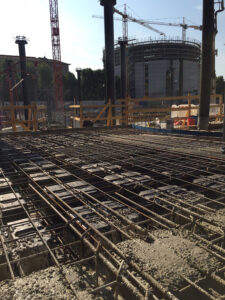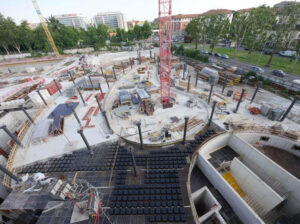U-Boot® Beton allows for a reduction in mass of up to 30% compared to a solid concrete slab, resulting in an overall reduction in load of between 10% and 20%.
The devastating force of an earthquake, causing damage to buildings and people, is an unpredictable natural event that can challenge our safety and stability. Therefore, it is important to proactively address the challenge of earthquakes through a combination of preparedness, scientific understanding and preventive action.
THE REGULATORY FRAMEWORK
One of the objectives of civil engineering is to ensure maximum resistance of structures to the effects of earthquakes, protecting human life and minimising structural damage to buildings. In this sense, all the most advanced technical standards that are the reference for designers, such as Eurocode 8 EN 1998-1, refer to two primary performance principles that must be satisfied: the protection of human life in the case of seismic events of infrequent intensity and the limitation of damage to structures in the case of seismic events that may occur with some frequency.
International standards for the design of horizontal slabs allow this type of deck to be considered not only as horizontally rigid, but also as a structure capable of dissipating seismic energy.
As a result of numerous experimental campaigns, it appears that the behaviour of slabs subjected to horizontal actions also allows these systems to be studied as primary in terms of seismic resistance.
Similar results are reported in the technical notebook developed by the Politecnico di Milano entitled “Reinforced concrete voided slabs subjected to gravity and seismic actions”- D.Coronelli, L. Martinelli, F. Foti – 2016. In the near future there will be a real revolution in the seismic analysis of buildings, which will give further impetus to the use of slabs in general and, consequently, to lightweight slabs.
A VOID FORMER MADE OF RECYCLED PLASTIC
During a seismic event, the force acting on the structural system is directly proportional to the mass of the building and the acceleration of the underlying ground. It is therefore obvious that if you want to reduce the actions involved, you can act on the mass of the building.
With a view to increasing the sustainability of buildings, the Daliform Group has developed a technological, practical and effective solution for creating voided biaxial slabs using U-Boot® Beton, a recycled plastic void former certified to the Second Life Plastic (PSV) standard by IPPR, the Institute for the Promotion of Recycled Plastics.
Although the use of slabs is not the only way to design a seismically resistant building, the choice of a two-way slab becomes the most usual when it is necessary, from an architectural point of view, to create structures with no regularity in the plan.
PROJECT FOCUS
A concrete example of the result of the above points is the new university campus in Milan, home to the SDA Bocconi School of Management.
An urban redevelopment project on the site of the former “Centrale del Latte”, designed by architects Kazuyo Sejima and Ryue Nishizawa of the Japanese studio Sanaa, covering an area of 36,000 square metres.
The decision to use U-Boot® Beton in this project enabled the creation of a sinuous and curved floor plan, deviating from typical designs and perfectly meeting high-performance standards. This approach resulted in a more slender load-bearing structure, even vertically. Compared to a solid slab of the same thickness, using U-Boot® Beton allows for a mass reduction of up to 30%, leading to an overall load reduction of between 10% and 20%.



